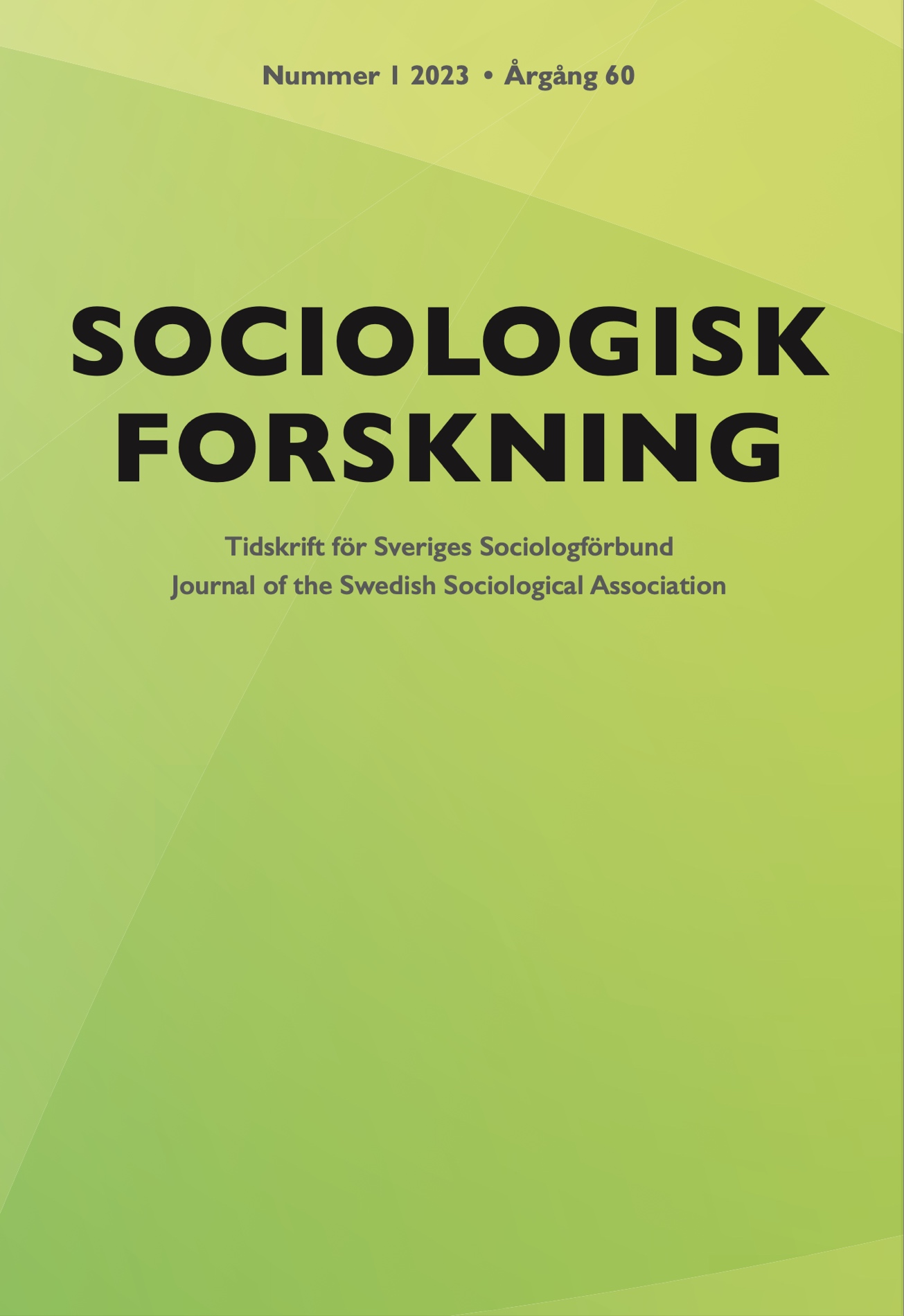The politics of responsibility
state-led gentrification and tenant organizing
DOI:
https://doi.org/10.37062/sf.60.24784Keywords:
state-led gentrification, responsibilization, tenant organizing, urban governance, territorial stigmatizationAbstract
During the 2010s, a number of projects have been initiated with the aim of "developing" city districts that have been classified as "vulnerable" or "particularly vulnerable". With a focus on Angered in Gothenburg, this article analyzes the governance strategies that have been dominant, what kind of conflicts they have generated, which strategies residents in the neighborhoods have developed to resist the ”development”” and the outcome of the conflicts. Based on critical urban research and governmentality theory, we distinguish three forms of shifting responsibilization: 1) from macro- to meso-level when municipal housing companies are given the responsibility of leading partnerships with private actors and non-profit organizations in a way that involves these actors in tasks that were previously the responsibility of the state, 2 ) from the meso- to the micro-level when municipal housing companies shift the responsibility for renovations and development of local environments to individual tenants, 3) from the micro-level back to the meso- and macro-level when residents of million program areas resist responsibilization and a re-responsibilization of the municipality and the central state.
References
Al-khamisi, R. (2015) ”Dialogen som blev en monolog”, 159–168 i T. Lindholm, S.O. de Costa & S. Wiberg (red.) Medborgardialog – demokrati eller dekoration? Stockholm: Arkus.
Baeten, G., S. Westin, E. Pull & I. Molina (2017) ”Pressure and violence. Housing renovation and displacement in Sweden”, Environment and Planning A 49 (3):631–651. https://doi.org/10.1177/0308518X16676271
Blixt. M., L. Molund Tunborn, L. Josgård, M. Ahlén, J. Larsson, M. Johansson, R. Hörnquist, M. Bergh, R. Ernebäck, M. Dolietis (2019) ”Vi tror och satsar stenhårt på Hjällbos framtid”, Göteborgs-Posten, 7 februari 2019.
Borelius, U. & U-B. Wennerström (2009) ”A New Gårdsten: A Case Study
of a Swedish Municipal Housing Company” European Journal of Housing Policy, 9 (2):223–239. https://doi.org/10.1080/14616710902920330
Boverket (2014) Flyttmönster till följd av omfattande renoveringar. Stockholm: Boverket.
Bridge, G., T. Butler & L. Lees (2012). Mixed Communities: Gentrification by stealth. Bristol: Polity Press. https://doi.org/10.1332/policypress/9781847424938.001.0001
Burchell, G. (1993) ”Liberal government and techniques of the self”, Economy and Society 22 (3):267–282. https://doi.org/10.1080/03085149300000018
Christophers, B. (2013) ”A monstrous hybrid: The political economy of housing in early twenty-first century Sweden”, New Political Economy 18 (6):885–911. https://doi.org/10.1080/13563467.2012.753521
Clark, E. & K. Johnson (2009) ”Circumventing circumscribed neoliberalism: The ’system switch’ in Swedish housing”, 173–194 i S. Glynn (red.) Where the other half lives: lower income housing in a neoliberal world, Bristol: Pluto.
Erlingsson. G. Ó., M. Fogelgren, F. Olsson, A. Thomasson & R. Öhrvall (2015) ”Att bolagisera kommunal verksamhet: implikationer för granskning, ansvarsutkrävande och demokrati?”, Statsvetenskaplig tidskrift 117 (4):555–585.
Esaiasson, P. (2019) Förorten: ett samhällsvetenskapligt reportage. Stockholm: Timbro.
Framtiden (2019) Avrapportering – Den politiska arbetsgruppen för blandade boendeformer. Styrelsehandling nr. 12 2019-4-11. Göteborg: AB Framtiden.
Framtiden (2020) Framtidenkoncernens strategi för utvecklingsområden 2020-2030. Göteborg: AB Framtiden.
Framtiden (2022) Revidering av riktlinje för varsam renovering. Göteborg: AB Framtiden.
Franzén, M., N. Hertting & C. Thörn (2016) Stad till salu: Entreprenörsurbanismen och det offentliga rummets värde. Göteborg: Daidalos.
Fryk, L. (2021) Hammarkullen 2020–2030. Från förort till europeisk utvecklingsområde. Göteborg: Hyresgästföreingen.
Grander, M. (2018) For the benefit of everyone? Explaining the significance of Swedish public housing for urban housing inequality. Malmö: Malmö University.
Görfedt, G. (2016) ”Lovar renovering utan hyreshöjning”, Hem & hyra, 13 maj 2016.
Hedin, K., E. Clark, E. Lundholm & G. Malmberg (2012) ”Neoliberalization of housing in Sweden: Gentrification, filtering and social polarization”, Annals of the Association of American Geographers 102 (2):1–21. https;//doi.org/10.1080/00045608.2011.620508
Hertting, N. (2003) Samverkan på spel. Växjö: Egalité.
Holmqvist, E. & L. M. Turner (2014) ”Swedish welfare state and housing markets: under economic and political pressure.” Journal of Housing and the Built Environment 29:237–254.
https://doi.org/10.1007/s10901-013-9391-0
Larsson, B., M. Letell, & H. Thörn. (red.) (2012) Transformations of the Swedish welfare state: From Social engineering to governance? Basingstoke: Palgrave Macmillan. https://doi.org/10.1057/9780230363953
Lind, H. (2020) Affären Gårdsten – en uppdatering 2020. Stockholm: KTH.
Lind, H. & S. Lundström (2008) Affären Gårdsten. Stockholm: KTH.
Lind, J-E. (2022) ”Lokala hyresgästorganisationer – roller, gemenskap och påverkan under tre årtionden: Röster och erfarenheter från bostadsområden och stadsdelar”, https://www.hyresgastforeningen.se/globalassets/fortroendevalda/lokala-hyresgastorganisationer210303_-janeriklind.pdf (hämtningsdatum 23 maj 2023).
Lindgren, H. (2021) ”What is the business of public housing? A new policy for Gothenburg’s ‘particularly vulnerable areas’”, masteruppsats, Göteborg: Göteborgs universitet, Institutionen för sociologi och arbetsvetenskap.
Lundberg, K. (2019) ”Hammarkullemodellen utmanar underifrån”. Offensiv, 21 maj 2019.
Lunneblad. J. & O. Sernhede (2022) ”Från välfärdsstat till partnerskap. Om förskjutning av ansvar i ”särskilt utsatta” områden”, Arkiv. Tidskrift för samhällsanalys, 14:33–52. https://doi.org/10.13068/2000-6217.14.2
Molina, I., & S. Westin (2012) ”Renoviction – even in Sweden? Four case studies on the regeneration of public housing estates”, Paper presenterat vid AAG Annual Meeting of the Association of American Geographers, New York, 2012.
Olsson, S., J-E. Lind & Lena Björk (2005). Framtidens stadsutveckling. Göteborg: Framtiden.
Polanska, D. V., & Å. Richard (2019) ”Narratives of a fractured trust in the Swedish model: Tenants’ emotions of renovation”, Culture Unbound 11(1):141–164. https://doi.org/10.3384/cu.2000.1525.2019111141
Polanska, D. V., & Å. Richard (2021) ”Resisting renovictions: tenants organizing against housing companies’ renewal practices in Sweden”, Radical Housing Journal 3 (1):187–205.
https://doi.org/10.54825/BNLM3593
Polanska, D. V., K. Backvall, Å. Richard & I. Molina (2022) ”Predatory commodification and housing renovation”, Journal of Urban Affairs. https://doi.org/10.1080/07352166.2022.2088375
Polisen NOA (2017) Utsatta områden – Social ordning, kriminell struktur och utmaningar för polisen. Nationella operativa avdelningen, Underrättelseenheten, Stockholm.
Poseidon (2019) Framtidens Hjällbo. Göteborg: Poseidon.
Pull, E. (2020) The original sin: On displacement through renoviction in Sweden. Doktorsavhandling, Roskilde: Roskilde University.
Regeringskansliet (2012) Urbana utvecklingsområden. Arbetsdepartementet, Dnr A2012/4115/IU.
Risager Skærlund, B. (2022) ”Rent gap governance”, City, 26 (2–3):199–223. https://doi.org/10.1080/13604813.2022.2042638
Rose, N. & P. Miller (2008) Governing the present: Administering economic, social and personal life. Cambridge: Polity Press.
Sahlin, I. (2010) I trygghetens namn. Göteborg: Daidalos.
Salonen, T. (red.) (2015) Nyttan med allmännyttan. Stockholm: Liber.
Salonen, T. (2021) Samhällsbygget Gårdsten – Allmännyttans framtid? Falun: Premiss förlag.
Scheller, D. & H. Thörn (2018) ”Governing ’sustainable urban development’ through self–build groups and cohousing: the cases of Hamburg and Gothenburg”, International Journal for Urban and Regional Research, 42 (5):914–933. https://doi.org/10.1111/1468-2427.12652
Schultz Larsen, T. & K. Nagel Delica (2019) ”The production of territorial stigmatisation”, City, 23 (4–5):540-563. https://doi.org/10.1080/13604813.2019.1682865
Sernhede, O. (2002) AlieNation is My Nation. Stockholm: Ordfront.
Sernhede, O. (2021) ”Hammarkullen – mellan motstånd och stigma”, Ord & Bild, 3, 135–144.
Sernhede, O., C. Thörn, & H. Thörn (2016) ”The Stockholm uprising in context: Urban social movements and the rise and demise of the Swedish welfare state city”, 149–174 i M. Mayer, C. Thörn & H. Thörn (red.) Urban uprisings: Challenging neoliberal urbanism in Europe Basingstoke: Palgrave Macmillan. https://doi.org/10.1057/978-1-137-50509-5
Slater, T. (2017) ”Territorial stigmatization: Symbolic defamation and the contemporary metropolis” 111–125 i J. Hannigan & G. Richards The SAGE Handbook of new urban studies, London: Sage.
Smith, N. (1996) The new urban frontier: Gentrification and the revanchist city. London & New York: Routledge.
Smith, N. 2002. ”New globalism, new urbanism: gentrification as a global urban strategy”, Antipode 34 (3):427–451. https://doi.org/10.1111/1467-8330.00249
SOU 1997:61. Att växa upp bland betong och kojor. Stockholm: Fritzes offentliga publikationer.
SOU 1997:118. Delade städer. Stockholm: Fritzes offentliga publikationer.
SOU 2005:29. Storstad i rörelse. Stockholm: Fritzes offentliga publikationer.
Stenberg, J. (2018) ”Dilemmas associated with tenant participation in renovation of housing in marginalized areas may lead to system change”, Cogent Social Sciences, 4 (1):1528710. https://doi.org/10.1080/23311886.2018.1528710
Strömbom, H. (2021) ”Pensionären Lasse stoppas från allmännyttan – får rätt av DO”. ETC, 8 oktober 2021.
Svärd, O. (2016) Företagare eller politiker? Göteborg: Göteborgs universitet.
Tahvilzadeh, N. & L. Kings (2018) ”Att göra kaos. Om förortspolitiken som urban styrregim och demokratiskt spel”, Arkiv 9:103–128.
Thörn, C. (2020) ”’We’re not moving’: Solidarity and collective housing struggle in a changing Sweden”, 175–195 i J. Krase and J. DeSena (red.) Gentrification around the World, Volume I,. Cham: Palgrave Macmillan. https://doi.org/10.1007/978-3-030-41337-8_8
Thörn, C. & Despotovic, K. (2015) Den urbana fronten. Stockholm: Arkitektur.
Thörn, C. & Holgersson, H., 2015. Gentrifiering. Lund: Studentlitteratur.
Thörn, C. & H. Holgersson (2016) ”Revisiting the urban frontier through the case of New Kvillebäcken, Gothenburg”, City, 20 (5):663–684. https://doi.org/10.1080/13604813.2016.1224479
Thörn, H. (2013) Stad i rörelse: stadsomvandlingen och striderna om Haga och Christiania. Stockholm: Atlas.
Thörn, H. & D. V. Polanska (2023) ”Responsibilizing renovation: governing strategies and resistance in the context of the transformation of Swedish housing policy”, City, 27 (1–2):209–231. https://doi.org/10.1080/13604813.2023.2170694
Thörn, H., E. Bogdanova, D. V. Polanska & L. Soneryd (red.) (2023) Standardhöjning eller underhåll? Deltagande och hållbarhet i renoveringar hyresbostäder. Stockholm: SCORE.
Törnquist, A. (2001) Till förortens försvar. Doktorsavhandling. Göteborgs universitet.
Uitermark, J., J. W. Duyvendak, & R. Kleinhans (2007) ”Gentrification as a governmental strategy: Social control and social cohesion in Hoogvliet, Rotterdam”, Environment and Planning A: Economy and Space, 39 (1):125–141. https://doi.org/10.1068/a39142
Wacquant, L. (2007) “Territorial stigmatization in the age of advanced marginality”, Thesis Eleven, 91 (1):66–77. https://doi.org/10.1177/0725513607082003
Downloads
Published
How to Cite
Issue
Section
License
Copyright (c) 2023 Håkan Thörn, Ove Sernhede, Hans Lindgren

This work is licensed under a Creative Commons Attribution-NonCommercial-NoDerivatives 4.0 International License.
All content in Sociologisk Forskning is published with immediate open access, under the Creative Commons license CC BY-NC-ND 4.0.
All content may be read, downloaded, shared and printed for non-commercial purposes, free and without fees. Contents may not be altered. When content is reused, author, source and a link to the copyright licence must be provided. The author retains copyright to their content. No publication fees are charged.





